
Dudleya, commonly known as liveforevers is a genus of succulent plants in the stonecrop family, Crassulaceae, consisting of about 68 taxa in southwestern North America and Guadalupe Island. The species come in multiple forms, some large and evergreen, others cryptic and deciduous. The flowers of Dudleya have parts numbered in 5, and when fruiting are filled with tiny, ovoid or crescent-shaped seeds.

Dudleya abramsiisubsp. setchellii, known by the common name Dudleya setchellii, the Santa Clara Valley dudleya, or Santa Clara Valley liveforever, is a member of the Dudleya genus of succulent perennials, members of the family Crassulaceae. The Santa Clara Valley dudleya, endemic to the Santa Clara Valley region in the southern San Francisco Bay Area, was listed on February 3, 1995, as an endangered species. It is considered to be a subspecies of Dudleya abramsii, but its taxonomic status is still unclear. Its closest relative is Dudleya cymosa subsp. paniculata, which is a morphologically similar sister taxon.

Dudleya abramsiisubsp.calcicola is a succulent plant known by the common name limestone liveforever, or limestone dudleya. It is endemic to California, where it is a rare resident of limestone outcroppings and rocky slopes in the southern Sierra Nevada and nearby mountains and foothills. It was formerly regarded as Dudleya calcicola.

Dudleya lanceolata is a succulent plant known by the common name lanceleaf liveforever or lance-leaved dudleya. It is an extremely variable and widely ranging species that occurs from Monterey County and Kern County in California south through Ensenada in Baja California. It is characterized by green to purple lanceolate leaves, red, orange, or less commonly yellow petals, and is typically tetraploid. Despite its diversity, it is quite stable as a species, but hybrids may be discovered with other species of Dudleya, which can make it difficult to discern in areas where numerous species converge.
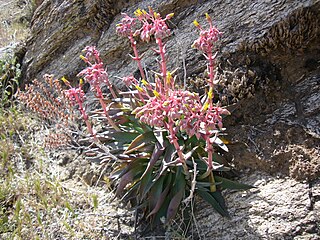
Dudleya saxosa is a perennial succulent plant species in the family Crassulaceae, within the genus Dudleya, which are commonly known as liveforevers. This species is a complex of 3 subspecies of plants, isolated and disjunct in distribution from one another, each with varying levels of ploidy and morphology. One plant is native throughout the deserts and mountains of Southern California, another is found in the Panamint Mountains, and one is found throughout central Arizona.

Dudleya greenei is a perennial species of succulent plant known by the common names Greene's liveforever, or Greene's dudleya. It is endemic to the Channel Islands of California, where it grows along the cliffs of four of the eight islands. It is a highly variable plant, presenting with multiple forms and varying levels of ploidy. Taxonomically, this species is an insular segregate of Dudleya caespitosa, and was placed as a stopgap taxon by Reid Moran in his 1951 thesis on the genus. It is characterized by white or green leaf rosettes, loomed over by inflorescences bearing pale yellow to white flowers. It is a member of the subgenus Dudleya, as it cannot be propagated from leaf cuttings, does not grow from a corm, and has tight petals.
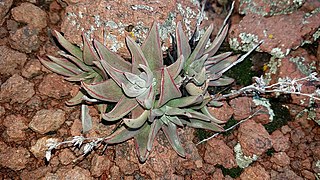
Dudleya abramsii is a species complex of succulent plants native to California and parts of Baja California. There are numerous subspecies, some critically endangered, with varying habits and lifestyles, but most often characterized by a smaller size, yellow flowers, and an affinity for rocky habitats. The subspecies may be polyphyletic.
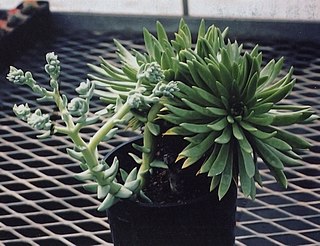
Dudleya guadalupensis is a very rare species of succulent perennial plant in the family Crassulaceae commonly known as the Guadalupe liveforever. It is a rosette-forming leaf succulent, with foliage that is variously colored light green, green, and a waxy white. It is characterized by dense leaves that fold over the center in dormancy, a curving, sinuous flower stalk, and white, cup-shaped flowers. It is endemic to the rocks and islets off of Guadalupe Island, an isolated volcanic island in the Pacific Ocean located 241 kilometers off of the coast of Baja California.

Dudleya rubens is a species of succulent perennial plant in the family Crassulaceae known by the common name as the San Francisco liveforever, native to the mountains of Baja California Sur. It is a rosette-forming plant with waxy leaves, characterized by branching stems and dull red to apricot flowers. It is only found above 500 metres (1,600 ft) in the Sierra de San Francisco and the Sierra de la Giganta ranges in Baja California Sur, primarily on north-facing volcanic slopes.

Dudleya arizonica, commonly known as the Arizona chalk dudleya and the Arizona liveforever, is a species of perennial succulent plant native to the southwestern United States and northwestern Mexico. It is one of two species of Dudleya that occur in Arizona, the other being Dudleya saxosa subsp. collomiae. It is the only Dudleya that occurs in Utah.

Dudleya saxosa subsp. collomiae, known by the common name Gila County liveforever, is a subspecies of perennial succulent plant within the genus Dudleya native to central Arizona.
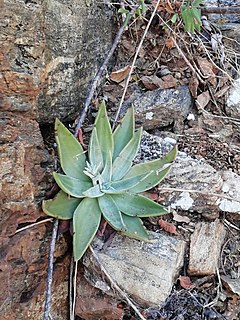
Dudleya nubigena is a species of succulent plants in the family Crassulaceae. It is a rosette forming perennial with flattish leaves. Endemic to southern Baja California Sur, the species is found in the Sierra de la Laguna and the surrounding lowlands, and on Cerralvo Island.

Dudleya abramsii subsp. affinis, commonly known as the San Bernardino Mountains Dudleya, is a subspecies of succulent plant endemic to a portion of the San Bernardino Mountains in California. It is a plant with an unbranching stem and elliptical leaves occurring in Green Canyon and the nearby plateaus.

Dudleya cymosa subsp. paniculata, known by the common name Diablo Range dudleya, is a species of perennial succulent plant in the family Crassulaceae native to the Inner South Coast Range of California. It is characterized by pale yellowish flowers, oblong to oblanceolate leaves and a growth habit not limited to a single substrate. It is closely related to Dudleya abramsii subsp. setchellii.
Dudleya cymosasubsp. costatifolia, known commonly as the Pierpoint Springs dudleya or the Pierpoint Springs liveforever, is a species of succulent plant in the family Crassulaceae, narrowly endemic to a locality in Tulare County, California, United States. It is a clumping plant with small rosettes and bright yellow flowers, resembling alpine "cushion plants."
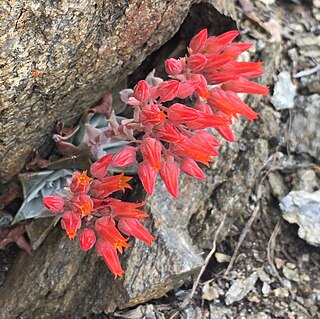
Dudleya cymosasubsp. pumila, most commonly known as the low canyon dudleya, chalky canyon dudleya or California live-forever, is a species of perennial succulent plant. It has diamond to spoon shaped leaves, sometimes coated with a fine white powder, and in May through July, bright red, orange or yellow flowers adorn the short inflorescence. A leaf succulent primarily found growing in rocky cliffs and slopes, it is endemic to California, and grows in the Transverse Ranges and South Coast Ranges, with some outlying populations. A variable plant, in some localities it is difficult to distinguish from other plants in the genus.

Dudleya saxosasubsp. aloides is a species of perennial succulent plant in the family Crassulaceae known by the common names desert dudleya or desert savior. It is a rosette-forming species widely distributed throughout the Peninsular Ranges and desert mountains of California in the United States. It is characterized by bright-yellow or greenish-yellow flowers, and can be found in shaded crevices and slopes. Plants in western half of the range may grade into Dudleya lanceolata.

Dudleya cymosasubsp. cymosa is a species of succulent perennial plant in the family Crassulaceae native to California. It is the autonymous subspecies for Dudleya cymosa, and is known by the common name canyon liveforever. It is native to the California Coast Ranges, the Sierra Nevada and the Santa Monica Mountains. It is characterized by bright-yellow, orange or red flowers and broad, wide leaves. This plant is commonly found growing on rocky outcrops, talus slopes, and in shaded canyons.
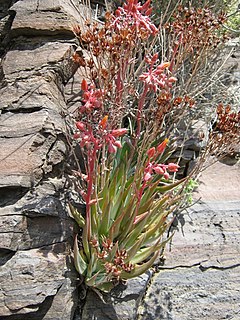
Dudleya saxosasubsp. saxosa is a species of succulent perennial plant endemic only to the western Panamint Range of California. It is known commonly as the Panamint liveforever or Panamint dudleya. It is found on north-facing, granitic or limestone slopes and grows up to 20 cm wide. It is characterized by bright yellow, red tinged flowers, which bloom from May to June.
Dudleya virens subsp. extima is a subspecies of succulent plant in the family Crassulaceae commonly known as the Guadalupe green liveforever. It is a rosette-forming leaf succulent, with both green and white waxy foliage. It has white flowers with spreading petals that bloom from May to June. It is a somewhat small plant, continuing a southward trend of decreasing size relative to other Dudleya virens subspecies. This species is endemic to Guadalupe Island in the eastern Pacific Ocean, which is 241 kilometers off of the Baja California coast. It is a very rare species, with this plant only surviving on sheer cliff faces and canyons, out of the reach of the former feral goat population rampant on the island. It closely resembles a miniature version of Dudleya virens subsp. virens, but it may be more nearly related to the local Dudleya guadalupensis.





















